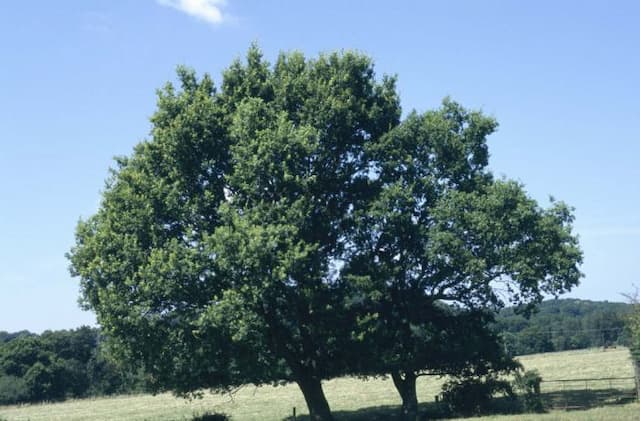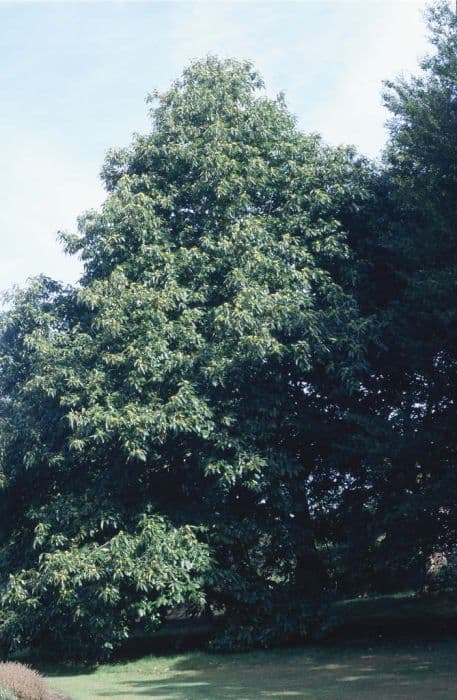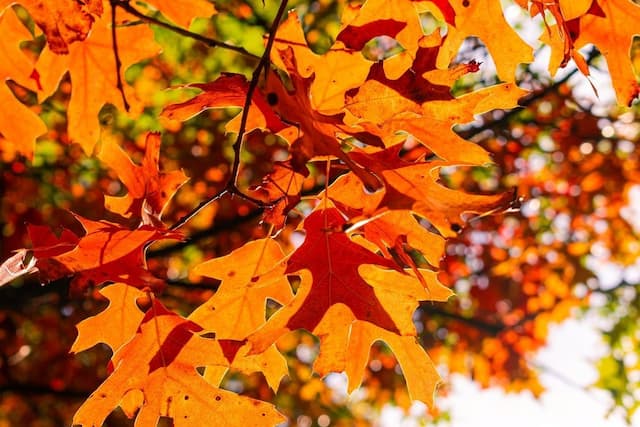Common beech Fagus sylvatica

ABOUT
Fagus sylvatica, also known as the European beech, is a deciduous tree that is native to Europe. The tree can reach a height of up to 130 feet and a trunk diameter of up to 4-5 feet in the wild.
The tree has a straight trunk with smooth, gray bark, and a spreading crown with a rounded canopy. The leaves are simple, alternate, and ovate-shaped, with a glossy green color and a serrated edge. The leaves are typically 4-6 inches long and 2-3 inches wide.
The tree produces inconspicuous flowers in the spring, which are followed by small, triangular nuts encased in a spiky, green husk. The nuts are edible and are known as beech nuts, they ripen between September and October.
The tree is known for its attractive bark and foliage and is often used as an ornamental tree in parks and gardens.
About this plant
 Names
NamesFamily
Fagaceae
Synonyms
Common beech, European beech
Common names
Castanea fagus, Fagus aenea, Fagus asplenifolia, Fagus cochleata, Fagus comptoniifolia, Fagus crispa, Fagus cristata, Fagus cucullata, Fagus cuprea, Fagus echinata, Fagus incisa, Fagus laciniata, Fagus pendula, Fagus purpurea, Fagus quercoides, Fagus salicifolia, Fagus sylvestris, Fagus variegata
 Toxicity
ToxicityTo humans
The toxicity of Fagus sylvatica to humans is relatively low, with no known major health concerns associated with this plant.
However, it is not recommended to ingest the bark or leaves of the plant as they may cause mild stomach upset.To pets
The toxicity of Fagus sylvatica to animals is also relatively low, with no known major health concerns associated with this plant.
However, it is not recommended to let animals ingest the bark or leaves of the plant as they may cause mild stomach upset.
 Characteristics
CharacteristicsLife cycle
Perennials
Foliage type
Deciduous
Color of leaves
Green; yellow in the fall
Flower color
Green
Height
Up to 130 feet
Spread
Up to 5 feet
Plant type
Tree
Hardiness zones
3
Native area
Europe, Asia
Benefits
 General Benefits
General BenefitsFagus sylvatica is a large, deciduous tree that can provide shade and shelter for people and animals;
The tree's beautiful green leaves and smooth, gray bark make it a popular choice for landscaping and ornamental gardens;
The wood of Fagus sylvatica is commonly used for furniture, flooring, and other wood products;
Fagus sylvatica has been revered for centuries for its beauty and practical uses, and is often featured in art, literature, and mythology. Medical Properties
Medical PropertiesThe bark, leaves, and nuts of the tree have been used to treat various ailments such as skin conditions, digestive issues, and respiratory problems. However, it is important to note that using plants as a stand-alone treatment can be dangerous and it is crucial to consult a specialist before using Fagus sylvatica or any other plant for medicinal purposes.
Some of the medical properties of Fagus sylvatica include:
The bark has anti-inflammatory and astringent properties, making it useful for treating skin conditions such as eczema and psoriasis;
The leaves contain flavonoids, which have antioxidant and anti-inflammatory properties. They can help to reduce the risk of heart disease and stroke;
The nuts of the tree are rich in minerals such as potassium, magnesium, and calcium and are often used to treat digestive issues;
Inhaling the essential oil of Fagus sylvatica can help to relieve respiratory problems such as asthma, bronchitis, and sinusitis. Air-purifying Qualities
Air-purifying QualitiesThe tree helps to improve air quality by absorbing carbon dioxide and releasing oxygen.
 Other Uses
Other UsesThe tree's hard, durable wood is often used for furniture, flooring, and other woodworking projects;
The wood of Fagus sylvatica burns well and is often used as firewood in the winter;
The tree's small leaves and delicate branches make it a popular choice for bonsai enthusiasts;
The nuts of the tree can be roasted or boiled and eaten, or pressed to make oil. Raw nuts in large quantities are harmful because of their phage alkaloid content.
Interesting Facts
 Zodiac Sign Compitability
Zodiac Sign CompitabilityTAURUS, CAPRICORN
It is known for its symbol of longevity, stability, and endurance in astrology. It is said to be compatible with the signs of Taurus and Capricorn, as they also embody these qualities of being grounded and reliable.
In astrology, Fagus sylvatica is also associated with the element of Earth, which is said to bring grounding energy to a space and promote a sense of calm and stability. Plant Symbolism
Plant SymbolismFagus sylvatica is a symbol of strength, resilience, and longevity;
It is a symbol of European forests and the beauty of nature;
It also stands for the power of nature and the importance of preserving it;
The leaves of this species are also seen as a symbol of luck and good fortune.
 Water
WaterIt is important to keep the soil consistently moist but not waterlogged.
The frequency of watering will depend on the conditions in your area, but in general, you should aim to water the tree once or twice a week. Light
LightThe best lighting conditions for Fagus sylvatica are full sun to partial shade.
The tree prefers to grow in a location that receives morning sun and afternoon shade. Temperature
TemperatureFagus sylvatica can tolerate a wide range of temperatures, but it prefers to grow in cool to moderate climates.
The best temperature range for this tree is between 50-75°F. It can tolerate temperatures as low as -20°F and as high as 95°F but it will not thrive in extreme temperatures. Pruning
PruningPruning Fagus sylvatica should be done in late winter or early spring before new growth begins. This will help to keep the tree healthy and promote strong growth. It is important to remove any dead or damaged branches, as well as any branches that are crossing or rubbing against each other. Thin out the crown of the tree to allow for better air circulation and light penetration. It is also important to maintain the shape of the tree and remove any branches that are growing too close to the ground.
 Soil
SoilThe best soil for Fagus sylvatica is well-drained, acidic to neutral soil with a pH range of 5.0-7.0. It prefers moist soil, but can tolerate dry soil as well. It is important to ensure that the soil does not become waterlogged.
 Humidity & Misting
Humidity & MistingThe ideal humidity level for Fagus sylvatica is between 40-60%.
It can tolerate lower humidity levels, but it is important to keep the soil moist to prevent the leaves from turning brown and falling off. Suitable locations
Suitable locationsIndoor
Not growing
Outdoor
All year round.
This is a hardy tree so can be grown in variety conditions.Hardiness zone
USDA 4 - 10
 Life cycle
Life cycleThe tree begins its life as a seed, which germinates in the spring or early summer. It takes about 1-2 months for the seed to germinate and grow into a small seedling.
During the first few years of its life, the tree is in the juvenile stage. During this stage, the tree is small and its leaves are a different shape than they will be as an adult.
As the tree grows, it enters the vegetative growth stage. During this stage, the tree's leaves become the characteristic beech leaf shape and the tree begins to grow rapidly. This stage can last for several decades.
Eventually, the tree reaches the reproductive stage. This is when the tree begins to produce flowers and fruit. The tree will continue to produce flowers and fruit for several decades.
After reaching maturity, the tree will continue to grow but at a slower rate. During this stage, the tree may begin to show signs of aging such as dead branches or a decline in overall health.
Eventually, the tree will reach the senescence stage, where it will begin to die. This stage can take several years. Propogation
PropogationPropogation time
Spring - early summer
By SEEDS:
Seeds can be collected from the tree in the fall and can be planted in the spring. It is important to stratify the seeds by keeping them in a damp, cool place for several weeks before planting.
By ROOT CUTTINGS:
Root cuttings can be taken from the tree in late winter or early spring. These cuttings should be about 4-6 inches long and should be planted immediately in a mixture of sand and peat moss. The cuttings should be kept in a cool, shaded area until they have rooted.
By GRAFTING:
This method involves taking a small piece of a mature tree and attaching it to a young sapling. This method is more difficult and is typically done by professional propagators.
 Pests
PestsCaterpillar, Gypsy moth
 Diseases
DiseasesRoot Rot, Powdery mildew, Leaf spot, Rust, Canker









